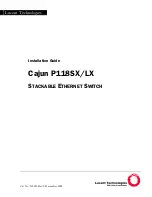
RUGGEDCOM ROX II
CLI User Guide
Chapter 10
Serial Server
Modbus TCP Applications
331
in a single packet, when the timer expires after receiving the very last character of the message. This is usually the
only packetizer selected when supporting Modbus TCP communications.
Finally, the serial server will always packetize and forward on a full packet, specifically when the number of
characters fills its communications buffer (1024 bytes).
Section 10.2.1.2
Modbus TCP Applications
The Modbus TCP Server application is used to transport Modbus requests and responses across IP networks. The
source of the polls is a Modbus
master
, a host computer that issues the polls to a remote host (RTU) connected
to the serial port of the device running the Modbus TCP Server application. The Modbus polls encapsulated in TCP
packets received by the device will be forwarded to the remote host via the serial port based on the host's address
defined in the RTU list. The responses from remote host are TCP encapsulated and returned to the
master
that
originated the polls.
Port Numbers
The TCP port number dedicated to Modbus use is port 502. The Modbus TCP Server application can also be
configured to accept a connection on a configurable port number. This auxiliary port can be used by masters that
do not support port 502.
Retransmissions
The Server Gateway offers the ability to resend a request to a remote host should the remote host receive the
request in error or the Server Gateway receives the remote host response in error.
The decision to use retransmissions, and the number to use, depends upon factors such as:
• The probability of a line failure.
• The number of remote hosts and the amount of traffic on the port.
• The cost of retransmitting the request from the server versus timing-out and retransmitting at the master. This
cost is affected by the speed of the ports and of the network.
ModBus Exception Handling
If the Server Gateway receives a request for an un-configured remote host, it will respond to the originator with
a special message called an exception (type 10). A type 11 exception is returned by the server if the remote host
fails to respond to requests.
Native Modbus TCP polling packages will want to receive these messages. Immediate indication of a failure can
accelerate recovery sequences and reduce the need for long timeouts.
Section 10.2.1.3
DNP Applications
RUGGEDCOM ROX II supports Distributed Network Protocol (DNP) version 3.0, commonly used by utilities in
process automation systems. DNP3 protocol messages specify source and destination addresses. A destination
address specifies which device should process the data, and the source address specifies which device sent
the message. Having both destination and source addresses satisfies at least one requirement for peer-to-peer
communication since the receiver knows where to direct a response.
Содержание RUGGEDCOM ROX II
Страница 2: ...RUGGEDCOM ROX II CLI User Guide ii ...
Страница 4: ...RUGGEDCOM ROX II CLI User Guide iv ...
Страница 39: ...RUGGEDCOM ROX II CLI User Guide Table of Contents xxxix 19 5 VLANs 752 ...
Страница 40: ...Table of Contents RUGGEDCOM ROX II CLI User Guide xl ...
Страница 46: ...Preface RUGGEDCOM ROX II CLI User Guide xlvi Customer Support ...
Страница 96: ...Chapter 2 Using RUGGEDCOM ROX II RUGGEDCOM ROX II CLI User Guide 50 Accessing Maintenance Mode ...
Страница 170: ...Chapter 5 System Administration RUGGEDCOM ROX II CLI User Guide 124 Deleting a Scheduled Job ...
Страница 256: ...Chapter 6 Security RUGGEDCOM ROX II CLI User Guide 210 Enabling Disabling a Firewall ...
Страница 402: ...Chapter 11 Wireless RUGGEDCOM ROX II CLI User Guide 356 Managing Cellular Modem Profiles ...
Страница 646: ...Chapter 13 Unicast and Multicast Routing RUGGEDCOM ROX II CLI User Guide 600 Deleting a Multicast Group Prefix ...
Страница 732: ...Chapter 15 Network Discovery and Management RUGGEDCOM ROX II CLI User Guide 686 Viewing NETCONF Statistics ...
Страница 790: ...Chapter 17 Time Services RUGGEDCOM ROX II CLI User Guide 744 Deleting a Broadcast Multicast Address ...
















































